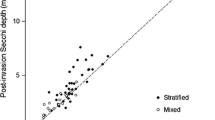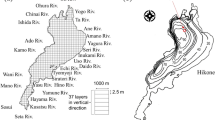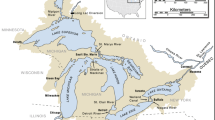Abstract
Many general mass-balance models that simulate processes in one or two water layers have been successfully constructed, tested and used to predict effects from remediating lake pollution and other environmental disturbances. However, these models are poorly suited for meromictic lakes which consist of yet another water layer. In order to determine a cross-systems based algorithm for the depth of the boundary between the two lowest layers (D crit2; in m), data from 24 three-layer lakes were analysed, and this depth could be predicted from the maximum depth and the lake surface area. The resulting model was tested with good results against independent data from 6 lakes which were not used for model development. Furthermore, D crit2 was predicted at a considerably lower depth than the theoretical wave base (a previously defined functional separator between the two top layers) in 110 out of 113 meromictic lakes. This indicates that the equation for D crit2 estimated in this study may be used for developing general mass-balance models for a large number of lakes which contain three stable water layers.


Similar content being viewed by others
References
Aldenberg, T., J. H. Janse & P. R. G. Kramer, 1995. Fitting the dynamic lake model PCLake to a multi-lake survey through Bayesian statistics. Ecological Modelling 78: 83–99.
Blenckner, T., 2008. Models as tools for understanding past, recent and future changes in large lakes. Hydrobiologia 599: 177–182.
Boehrer, B. & M. Schultze, 2008. Stratification of lakes. Reviews of Geophysics 46: RG2005.
Bossard, P., S. Gammeter, C. Lehmann, F. Schanz, R. Bachofen, H.-R. Bürgi, D. Steiner & U. Zimmermann, 2001. Limnological description of the Lakes Zürich, Lucerne, and Cadagno. Aquatic Sciences 63: 225–249.
Brezonik, P. L. & J. L. Fox, 1974. The limnology of selected Guatemalan lakes. Hydrobiologia 45: 467–487.
Bryhn, A. C. & L. Håkanson, 2007. A comparison of predictive phosphorus load-concentration models for lakes. Ecosystems 10: 1084–1099.
Burton, H. R., 1980. Methane in a saline Antarctic lake. In Trudinger, P. A. & M. R. Walter (eds), Biogeochemistry of Ancient and Modern Environments. Proceedings of the Fourth International Symposium on Environmental Biogeochemistry (ISEB). Australian Academy of Science, Canberra: 243–251.
Casamayor, E. O., H. Schafer, L. Baneras, C. Pedros-Alio & G. Muyzer, 2000. Identification of and spatio-temporal differences between microbial assemblages from two neighboring sulfurous lakes: Comparison by microscopy and denaturing gradient gel electrophoresis. Applied and Environmental Microbiology 66: 499–508.
Fry, B., 1986. Sources of carbon and sulfur nutrition for consumers in three meromictic lakes of New York State. Limnology and Oceanography 31: 79–88.
Goldman, C. R., D. T. Mason & J. E. Hobbie, 1967. Two Antarctic desert lakes. Limnology and Oceanography 12: 295–310.
Hakala, A., 2004. Meromixis as a part of lake evolution: Observations and a revised classification of true meromictic lakes in Finland. Boreal Environment Research 9: 37–53.
Hakala, A., 2005. Paleoenvironmental and paleoclimatic studies on the sediments of Lake Vähä-Pitkusta and observations of meromixis. Ph.D. thesis, extended summary. University of Helsinki, Helsinki.
Håkanson, L., 2006. Suspended particulate matter in lakes, rivers, and marine systems. The Blackburn Press, New Jersey.
Håkanson, L. & A. C. Bryhn, 2008. A dynamic mass-balance model for phosphorus in lakes with a focus on criteria for applicability and boundary conditions. Water, Air, & Soil Pollution 187: 119–147.
Håkanson, L., T. Blenckner & J. M. Malmaeus, 2004. New, general methods to define the depth separating surface water from deep water, outflow and internal loading for mass-balance models for lakes. Ecological Modelling 175: 339–352.
Hongve, D., 1980. Chemical stratification and stability of meromictic lakes in the Upper Romerike district. Schweizerische Zeitschrift für Hydrologie 42: 171–195.
Jacquet, S., J.-F. Briand, C. Leboulanger, C. Avois-Jacquet, L. Oberhaus, B. Tassin, B. Vinçon-Leite, G. Paolini, J.-C. Druart, O. Anneville & J.-F. Humbert, 2005. The proliferation of the toxic cyanobacterium Planktothrix rubescens following restoration of the largest natural French lake (Lac du Bourget). Harmful Algae 4: 651–672.
Ouellet, M., M. Dickman, M. Bisson & P. Page, 1989. Physico-chemical characteristics and origin of hypersaline meromictic Lake Garrow in the Canadian High Arctic. Hydrobiologia 172: 215–234.
Rodrigo, M. A., M. R. Miracle & E. Vicente, 2001. The meromictic Lake La Cruz (Central Spain): Patterns of stratification. Aquatic Sciences 63: 406–416.
Sherstyankin, P. P., S. P. Alekseev, A. M. Abramov, K. G. Stavrov, M. De Batist, R. Hus, M. Canals & J. L. Casamor, 2006. Computer-based bathymetric map of Lake Baikal. Doklady Earth Sciences 408: 564–569.
Straškrábová, V., L. R. Izmest’yeva, E. A. Maksimova, S. Fietz, J. Nedoma, J. Borovec, G. I. Kobanovac, E. V. Shchetinina & E. V. Pislegina, 2005. Primary production and microbial activity in the euphotic zone of Lake Baikal (Southern Basin) during late winter. Global and Planetary Change 46: 57–73.
Taguchi, K. & K. Nakata, 1998. Analysis of water quality in Lake Hamana using a coupled physical and biochemical model. Journal of Marine Systems 16: 107–132.
Vinçon-Leite, B., B. Tassin & J.-C. Druart, 2002. Phytoplankton variability in Lake Bourget: Phytoplankton dynamics and meteorology. Lakes & Reservoirs: Research and Management 7: 93–102.
Walker, K. F. & G. E. Likens, 1975. Meromixis and a reconsidered typology of lake circulation patterns. Internationale Vereinigung für Theoretische und Angewandte Limnologie: Verhandlungen 19: 442–458.
Wetzel, R. G., 2001. Limnology, 3rd ed. Academic Press, London.
Acknowledgements
The author is very grateful to the editorial board of Hydrobiologia and two anonymous reviewers for improving earlier versions of this article.
Author information
Authors and Affiliations
Corresponding author
Additional information
Handling editor: Luis Mauricio Bini
Rights and permissions
About this article
Cite this article
Bryhn, A.C. A morphometrically based method for predicting water layer boundaries in meromictic lakes. Hydrobiologia 636, 413–419 (2009). https://doi.org/10.1007/s10750-009-9970-y
Received:
Revised:
Accepted:
Published:
Issue Date:
DOI: https://doi.org/10.1007/s10750-009-9970-y




